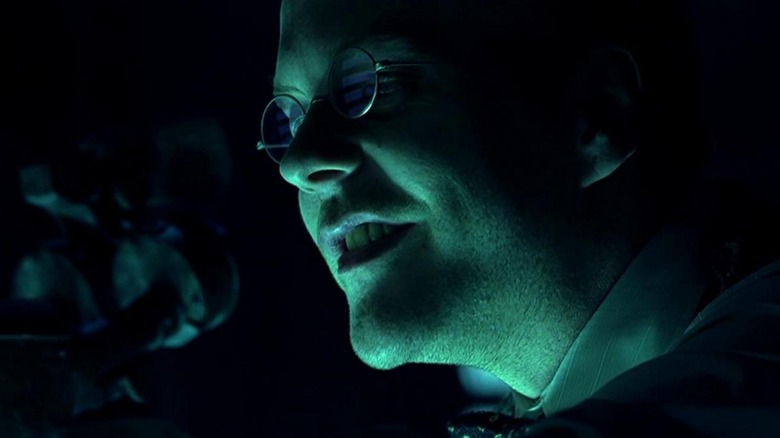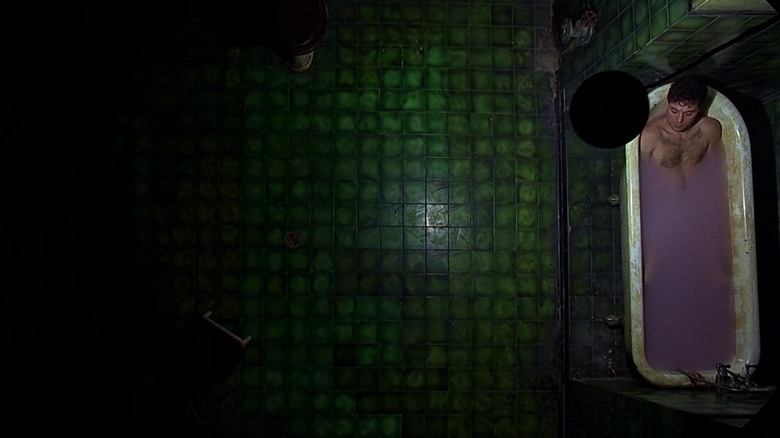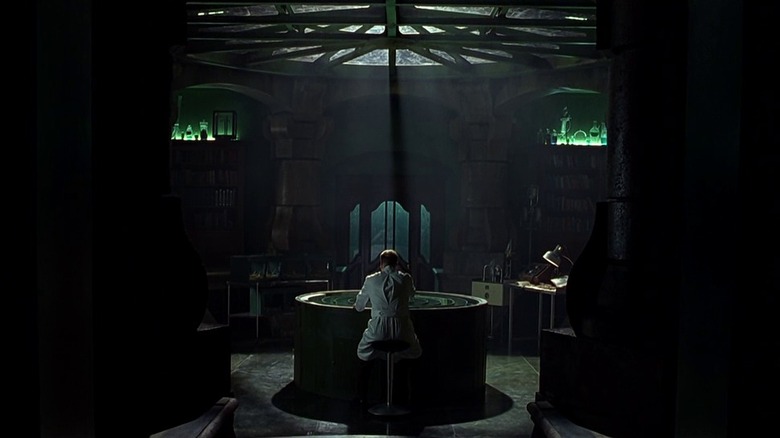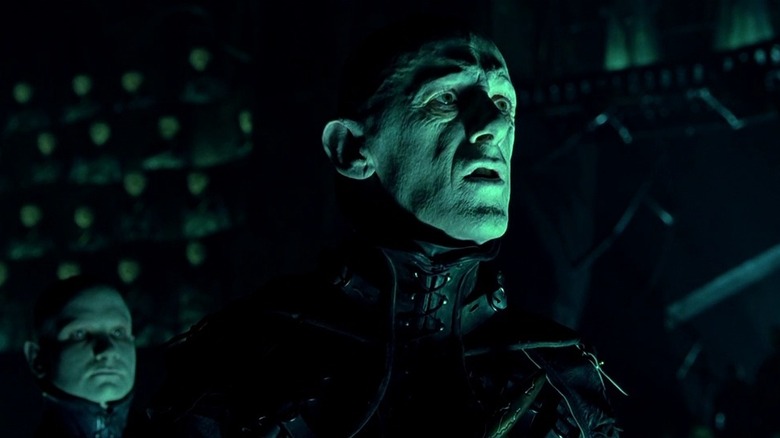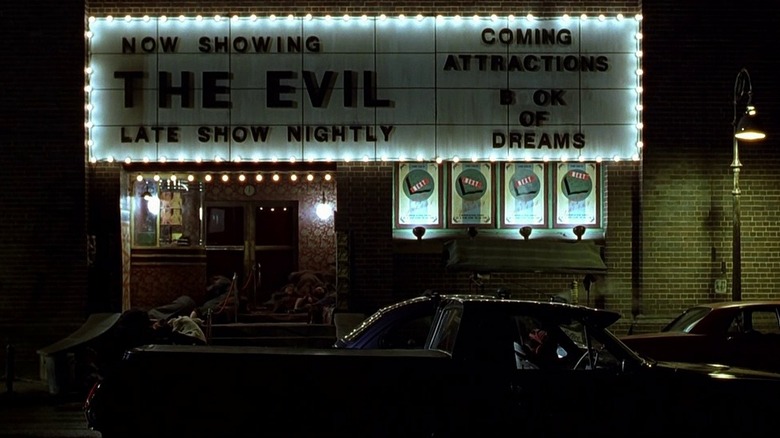Kiefer Sutherland Considers Dark City The 'Highest Form Of Film Making'
Kiefer Sutherland is best known for playing Jack Bauer in "24," the defining TV drama of George W. Bush's presidency. Few other series from that time — as dramatized by YouTuber and sports writer Jon Bois in his classic video "I Wish Everyone Else Was Dead" — capture the country's reverence for and fear of its own power as effectively. Sutherland would love to step into Bauer's shoes again too. After all, he had a great time on the long-running series, once telling Collider that he compares his experience acting on "24" to the training regimen of an Olympic runner.
"When I got to do '24,' I got to work every day," he says. "I feel that my knowledge of the craft of acting grew exponentially during that time period." The success of "24" opened new doors for Sutherland. Game director Hideo Kojima hired him to voice Venom Snake in 2015's "Metal Gear Solid V: The Phantom Pain," displacing actor David Hayter. A year later, he remixed his heroic everyman character in the short-lived political thriller TV series "Designated Survivor."
But Sutherland had a career before "24" too. At the age of 18, he was the lead in director Daniel Petrie's semi-autobiographical "The Bay Boy." He was part of the famous 1986 coming-of-age movie "Stand By Me," as well as Joe Schumacher's 1987 cult picture "The Lost Boys." But there is another classic Sutherland film that has nearly been forgotten these days. "'Dark City' will always hold a special place in my heart," he told Collider in March 2022. "I believe that, creatively, it approaches what I consider to be cinema, which is the highest form of filmmaking."
Where the night never ends
"Dark City" was directed by Alex Proyas, an Australian filmmaker who broke into Hollywood via the infamous 1994 comic adaptation "The Crow." The neo-noir sci-fi thriller followed an amnesiac (Rufus Sewell) struggling to survive in an ever-changing city that is controlled by blank-faced men. The film borrows as eagerly from the 1988 anime classic "Akira" as it does from 1927's German expressionist masterpiece "Metropolis."
Just like "Blade Runner" — another cult film that found a second life on video — Proyas was compelled by studio executives to add an explanatory voiceover to the opening minutes so that audiences wouldn't be confused. "Dark City" flopped regardless upon its release in February 1998, one year before "The Matrix" captured the zeitgeist. It wasn't until the release of the Director's Cut on DVD, which restored a sense of mystery to the first half hour, that the film could be appreciated for what it was.
"Dark City" has since been hailed as a visionary film that arrived before audiences were ready for it. The late renowned film critic Roger Ebert scored it higher than "The Matrix" and its sequels. I saw it for the first time in high school, after reading about it in "The Encyclopedia of Science Fiction." It was just about perfect then. It's a tougher watch now — the dialogue and acting are inconsistent when compared to "The Matrix," and the construction of its world is riddled with holes despite great set design and art direction. Still, the film is visually and thematically ambitious, and even featured a young David Goyer back when he was writing scripts for "Blade."
Being Dr. Schreber
According to "The Encyclopedia of Science Fiction," Alex Proyas was "strongly inspired by Daniel P. Schreber's pioneering account of his paranoid psychosis" titled "Memoirs of My Nervous Illness." An earlier version of "Dark City" focused on a detective driven mad by his conviction that the world does not make sense. Later drafts shifted the point of view to his quarry, the amnesiac John Murdoch.
But elements of the earlier version remain. Detective Eddie Walenski, the conspiracy-minded (and correct) former colleague of police inspector Frank Bumstead, clearly descends from the original hero of "Dark City." Murdoch struggles with the fear that he really is the monster that everybody says he is. Meanwhile, the psychologist that collaborates with the Strangers in their experiments is named after Daniel P. Schreber.
It was this character that Keifer Sutherland latched onto when he first read the script for "Dark City." When he met with Proyas for the first time to talk about the film, he had already memorized passages of dialogue. Then and there, "in the middle of the bar of the hotel," he delivered an impromptu performance.
"I started playing Schreber, and with the voice, and the walk and all of it," Sutherland told Collider. Proyas was stunned by his enthusiasm. In fact, Sutherland admitted that "I think I scared him a little bit." But Proyas decided to go with him, even though he had imagined an older actor like Ben Kingsley in the role. De-aging Schreber "made the character more tragic," Proyas told SPLICEDwire in February 1998. "[Sutherland has] still got his whole ... career ahead of him and it's going to be ruled by the Strangers."
Creating a world that only exists in my head
Schreber is the key to the world of "Dark City." He works directly with the Strangers each night to implant the inhabitants of the city with new memories. The Strangers themselves are responsible for "tuning" the city and its structures. But without Schreber's medical expertise or understanding of human nature, the Strangers could never hope to study humanity.
Despite the importance of psychology to "Dark City" though, the film never gives Schreber a distinct personality. Kiefer Sutherland plays the character as a broad archetype, squinting through small round glasses as he speaks in sentences laden with pregnant pauses. Despite being the only stable human in a cast of mutable humans and aliens, he fails to latch onto anything real.
Perhaps that's simply the kind of film "Dark City" is. As a child, director Alex Proyas dabbled in stop-motion and animation as well as live-action. His titular Dark City is no generic Matrix cityscape, but instead a labyrinth of anachronisms, twisted architecture, and macabre visual gags.
"The ultimate creative thrill of making a film, Proyas told the blog Money Into Light in 2017, "is ... creating a world that only exists in my head." "Dark City" did not belong to Proyas alone. Patrick Tatopoulos's production design was central to the film's success, as was Peter Pound's storyboarding and concept art. Not to mention actors like Sutherland who devoted themselves to creating the heightened reality of "Dark City." But to Proyas, perhaps, the characters of "Dark City" were archetypical on purpose. It is his imagined world — which he had been developing since at least 1990 — that is truly alive.
The highest form of film-making
In the years since, Alex Proyas has struggled to return to the heights of "Dark City." His 2004 sci-fi blockbuster "I, Robot" was reportedly micromanaged to death by Hollywood. His 2009 sci-fi thriller "Knowing" received a chilly reception despite earning another rapturous review from Roger Ebert. His most recent film, the 2016 fantasy action "Gods of Egypt," led Proyas to write a Facebook post where he called film critics "deranged idiots."
These critics, to his mind, were so keen to tear down filmmakers that they risked destroying ambitious art in its cradle. "I encourage filmmakers to tell stories that only they can tell," Proyas said to Money Into Light. "I want to see the filmmaker's soul on screen." In that last respect, Proyas is right and he should say it. But that doesn't explain his recent dabbling with another, stranger world than "Dark City": AI art.
"AI image generators are doing for video what the synthesizer and sequencer did for music," he wrote in the description of an August 2022 video titled "The Unfolding Nightmare" hosted on his YouTube channel. "Like it or not, this is the future." Proyas created the images in this video via the AI program Midjourney. Possibly he sees AI as just another medium in the vein of live-action or animation. But Midjourney and its competitor Stable Diffusion are also plagiarism machines, according to a suit organized by artists Sarah Anderson, Kelly McKernan, and Karla Ortiz. Midjourney generates its results based on billions of internet art pieces "without the knowledge or consent of the artists."
By participating in this process, Proyas is accelerating the destruction of the idiosyncratic, personal films he claims to love. What Kiefer Sutherland once called "the highest form of film-making" is now his to lose.
